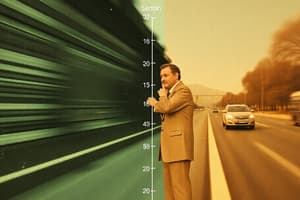Podcast
Questions and Answers
What is Speed?
What is Speed?
distance ÷ time
What is the shape of a distance-time graph when the object is at rest?
What is the shape of a distance-time graph when the object is at rest?
a horizontal line
What is the shape of a distance-time graph when the object is moving with constant speed?
What is the shape of a distance-time graph when the object is moving with constant speed?
a slanted line
What is the shape of a distance-time graph when the object is moving with changing speed?
What is the shape of a distance-time graph when the object is moving with changing speed?
What is the distance traveled for motion with constant acceleration in a speed-time graph?
What is the distance traveled for motion with constant acceleration in a speed-time graph?
If a body accelerates, its speed-time graph will have a...
If a body accelerates, its speed-time graph will have a...
If a body decelerates, its speed-time graph will have a...
If a body decelerates, its speed-time graph will have a...
What is the difference between speed and velocity?
What is the difference between speed and velocity?
What does 'a' stand for in physics?
What does 'a' stand for in physics?
On a distance-time graph, speed is represented by...
On a distance-time graph, speed is represented by...
On a speed-time graph, acceleration is represented by...
On a speed-time graph, acceleration is represented by...
On a speed-time graph, a straight line with a positive gradient means...
On a speed-time graph, a straight line with a positive gradient means...
On a speed-time graph, a curved line with a positive gradient means...
On a speed-time graph, a curved line with a positive gradient means...
What is deceleration?
What is deceleration?
What is the mass of a body?
What is the mass of a body?
Weight is a _____________ force.
Weight is a _____________ force.
What is the difference between mass and weight?
What is the difference between mass and weight?
What is the formula for weight (W)?
What is the formula for weight (W)?
How do you compare weights using balance?
How do you compare weights using balance?
What is 'inertia'?
What is 'inertia'?
What is the definition of weight?
What is the definition of weight?
What does ρ mean?
What does ρ mean?
Describe an experiment to determine the density of a liquid and a regularly shaped solid.
Describe an experiment to determine the density of a liquid and a regularly shaped solid.
Describe the determination of the density of an irregularly shaped solid by the method of displacement.
Describe the determination of the density of an irregularly shaped solid by the method of displacement.
How do you predict whether an object will float based on density data?
How do you predict whether an object will float based on density data?
A force may produce a change in ____ ___ _____ of a body.
A force may produce a change in ____ ___ _____ of a body.
Describe the ways in which a force may change a body.
Describe the ways in which a force may change a body.
If two or more forces are acting on the same line, the resultant force is equal to...
If two or more forces are acting on the same line, the resultant force is equal to...
If there is no resultant force on a body, it...
If there is no resultant force on a body, it...
What is friction?
What is friction?
What is air resistance?
What is air resistance?
State Hooke's Law.
State Hooke's Law.
What does F stand for in Hooke's Law?
What does F stand for in Hooke's Law?
What is the significance of the 'limit of proportionality' for an extension-load graph?
What is the significance of the 'limit of proportionality' for an extension-load graph?
What is the 'limit of proportionality'?
What is the 'limit of proportionality'?
Flashcards
Speed
Speed
Distance traveled divided by time taken.
Distance-time graph
Distance-time graph
A graph showing changes in distance over time.
Constant speed
Constant speed
A steady pace of motion.
Acceleration
Acceleration
Signup and view all the flashcards
Positive gradient
Positive gradient
Signup and view all the flashcards
Negative gradient
Negative gradient
Signup and view all the flashcards
Velocity
Velocity
Signup and view all the flashcards
Acceleration (a)
Acceleration (a)
Signup and view all the flashcards
Speed on a distance-time graph
Speed on a distance-time graph
Signup and view all the flashcards
Acceleration on a speed-time graph
Acceleration on a speed-time graph
Signup and view all the flashcards
Constant acceleration
Constant acceleration
Signup and view all the flashcards
Changing acceleration
Changing acceleration
Signup and view all the flashcards
Deceleration
Deceleration
Signup and view all the flashcards
Mass
Mass
Signup and view all the flashcards
Weight
Weight
Signup and view all the flashcards
Weight (W)
Weight (W)
Signup and view all the flashcards
Density
Density
Signup and view all the flashcards
Density (ρ)
Density (ρ)
Signup and view all the flashcards
Method of displacement
Method of displacement
Signup and view all the flashcards
Floating
Floating
Signup and view all the flashcards
Force
Force
Signup and view all the flashcards
Resultant force
Resultant force
Signup and view all the flashcards
No resultant force
No resultant force
Signup and view all the flashcards
Friction
Friction
Signup and view all the flashcards
Air resistance
Air resistance
Signup and view all the flashcards
Hooke's Law
Hooke's Law
Signup and view all the flashcards
Limit of proportionality
Limit of proportionality
Signup and view all the flashcards
Study Notes
Speed and Motion
- Speed is calculated as distance divided by time.
- A distance-time graph displays a horizontal line when an object is at rest.
- A constant speed results in a slanted line on a distance-time graph.
- A curved line indicates changing speed in a distance-time graph.
- In speed-time graphs, the area under the graph represents the distance traveled during constant acceleration.
- A speed-time graph shows a positive gradient for accelerating bodies and a negative gradient for decelerating bodies.
- Speed is a scalar quantity, while velocity is a vector with both magnitude and direction.
Acceleration
- Acceleration (a) is defined as the change in velocity (∆v) divided by time (t).
- On a distance-time graph, speed is represented by the gradient of the line.
- Acceleration on a speed-time graph is also indicated by the gradient.
- A straight line with a positive gradient on a speed-time graph indicates constant acceleration.
- A curved line with a positive gradient suggests changing acceleration.
- Deceleration is synonymous with negative acceleration.
Mass and Weight
- Mass refers to the number of particles in a body.
- Weight is a gravitational force acting on a mass.
- The difference between mass and weight lies in gravitational field strength affecting weight; mass remains constant.
- Weight (W) is calculated using the formula W = m × g, where g is the acceleration due to gravity.
- Comparison of weights using a balance scales involves placing weights on either side and determining which side is heavier.
Density
- Density (ρ) is calculated as mass (m) multiplied by volume (V).
- To find the density of a liquid or regular solid, weigh the object, measure the volume, and apply the density formula (ρ = m/V).
- The method of displacement is used for irregularly shaped solids: submerge the solid in water to measure the volume displaced and then find density.
- An object will float if its density is less than that of the liquid it's placed in.
Forces and Motion
- A force can alter the size and shape of a body.
- Forces can provoke changes in speed, direction, or shape of an object.
- When forces act along the same line, the resultant force is the sum of the individual forces.
- A body with no resultant force will either remain still or move at a constant speed in a straight line.
- Friction is the force between two surfaces that hinders motion and generates heat.
- Air resistance is a specific type of friction experienced by objects moving through the air.
Hooke's Law
- Hooke's Law states that the force (F) required to extend or compress a spring is proportional to the distance (e) it is stretched or compressed.
- The relationship in Hooke's Law is expressed as F = k × e, where k is the spring constant.
- The limit of proportionality refers to the point on an extension-load graph beyond which the relationship no longer remains linear and begins to curve.
Studying That Suits You
Use AI to generate personalized quizzes and flashcards to suit your learning preferences.




